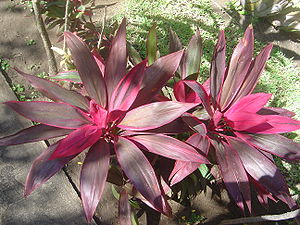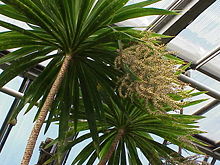Club lilies
| Club lilies | ||||||||||||
|---|---|---|---|---|---|---|---|---|---|---|---|---|

Cordyline fruticosa - cultivar, one of the many varieties that are also suitable as houseplant |
||||||||||||
| Systematics | ||||||||||||
|
||||||||||||
| Scientific name | ||||||||||||
| Cordyline | ||||||||||||
| Comm. ex Juss. |
Cordyline ( Cordyline ) are a genus of subfamily of lomandroideae in the family of asparagaceae (Asparagaceae) within the order of the asparagus-like (Asparagales). Many species that were earlier in this genus have been placed in the Dracaena genus . Cordyline form club-shaped storage lumps at the roots (German name!). Some species and varieties are ornamental plants . Some species and especially their varieties have variegated leaves, often red, which is why they are used as ornamental plants in frost-free areas in parks and gardens, but also as indoor plants .
description


There are perennial herbaceous and woody species. The lignified species are only tree-shaped or shrub-shaped life forms and not trees. The more or less woody shoot axes are usually not very branched with clear leaf scars. The alternate leaves stand together in a rosette. The leaves are divided into leaf sheath, petiole and leaf blade. Sometimes a petiole is missing, otherwise it is 10 to 30 cm long. The more or less wide leaf blades have largely parallel leaf veins , but with side veins that extend from the midrib.
Branchy, relatively large panicle inflorescences develop in the leaf axils of the uppermost leaves . The mostly short-stalked flowers are hermaphroditic and threefold. The six identical bloom bracts are tubular, bell-shaped to almost cylindrical fused. The six stamens are fused with the flower envelope. Three carpels have become a top permanent ovary grown from two to many ovules per ovary chamber. The slender stylus ends in a small, heady scar.
The leathery berries contain one to a few seeds. The seeds are black due to phytomelanin .
distribution
Their distribution area extends from Papua Asia to the islands in the western Pacific, from Bolivia to southern South America and also includes the Mascarene Islands. Eight species are native to Australia .
Systematics

The genus Cordyline was first published in 1789 by Philibert Commerson in Antoine Laurent de Jussieu : Genera Plantarum , page 41 or by Philibert Commerson in Robert Brown: Prodromus Florae Novae Hollandiae , page 280, not until 1810.
Synonyms for Cordyline Comm. ex Juss. are: Taetsia Medik. , Carlwoodia Sweet , Charlwoodia Sweet , Euphyleia Raf. , Calodracon Planch. , Cohnia Kunth , Dracaenopsis Planch. , Ezehlsia Lour. ex BAGomes , Terminalis Medik. nom. rej.
The genus of club lilies ( Cordyline ) includes about 24 species:
- Cordyline angustissima K.Schum. : It occurs in New Guinea.
- Cordyline australis (G.Forst.) Endl. (Syn .: Dracaena australis G.Forst. ): It occurs in New Zealand.
- Cordyline banksii hook. f. : The home is New Zealand.
- Cordyline cannifolia R.Br. : It occurs in Australia in northeast Queensland and in northeast Northern Territory .
- Cordyline casanovae Linden ex André : It only occurs in Vanuatu .
- Cordyline congesta (Sweet) Steud. (Syn .: Cordyline dracaenoides Kunth , Cordyline spectabilis Kunth & CDBouché ): It occurs in Australia in southeastern Queensland and in northeastern New South Wales.
- Cordyline forbesii Rendle : It occurs in Papua New Guinea.
- Cordyline fruticosa (L.) A. Chev. (Syn .: Cordyline terminalis Kunth , Cordyline densicoma Linden & André , Cordyline guilfoylei Lem. ): It is native to Papua Asia to the islands of the western Pacific.
- Cordyline × gibbingsiae Carse = Cordyline banksii × Cordyline pumilio . It occurs in New Zealand.
- Cordyline indivisa (G. Forst.) Steud. : It occurs in New Zealand.
- Cordyline lateralis Lauterb. : It occurs in New Guinea.
- Cordyline ledermannii K. Krause : It occurs in New Guinea.
- Cordyline manners-suttoniae F. Muell. : It occurs in northeast Queensland.
- Cordyline × matthewsii Carse = Cordyline australis × Cordyline pumilio : It occurs in New Zealand.
- Cordyline mauritiana (Lam.) JFMacbr. : It occurs on Mauritius and Réunion .
- Cordyline minutiflora Ridl. : It occurs in New Guinea.
- Cordyline murchisoniae F. Muell. : It occurs in eastern Queensland.
- Cordyline neocaledonica (Baker) BDJacks. : It occurs in New Caledonia .
- Cordyline obtecta (Graham) Baker : It occurs on the North Island of New Zealand and on the Norfolk Island .
- Cordyline petiolarlis (Domin) Pedley : Endemic to northeastern New South Wales and southeastern Queensland (in eastern Australia ).
- Cordyline pumilio Hook.f. : It occurs on the North Island of New Zealand.
- Cordyline racemosa Ridl. : It occurs in New Guinea.
- Cordyline rubra Otto & A.Dietr. : It occurs in Australia in southeastern Queensland and in northeastern New South Wales.
- Cordyline worsei Lauterb. : It occurs in New Guinea.
- Cordyline sellowiana Kunth : It occurs from Bolivia to Brazil, Uruguay, Paraguay and northern Argentina.
- Cordyline stricta (Sims) Endl. : It occurs in Australia in southeastern Queensland and in northeastern New South Wales.
The genus Cordyline was previously placed in the families Agavaceae , Liliaceae or Asteliaceae .
Ethnobotany
In the central highlands of western New Guinea , a Cordyline species is a sacred plant among the Eipo . It is planted at the men's house. This rite is a symbolic repetition of the process of creation.
In Polynesia, the sacred and auspicious Ti or Kī plant ( Cordyline terminalis or Cordyline fruticosa ) was planted not far from the temple complexes ( marae ). The Polynesians made black tattoo ink from the burnt parts of the plant . Okolehao schnapps is made in Hawaii from the fermented rhizome of Cordyline fruticosa .
In New Zealand, the starchy stems and fleshy rhizomes of both Tī Pore or Dwarf Cabbage Tree (Cordyline pumilio) and Tī Kōuka , Cabbage Tree (Cordyline australis) are steamed by the Maori to produce the sweetener kāuru . The delicate tips and the inside of the leaf were eaten raw as vegetables. The taste of Tī Kōuka (Cordyline australis ) was considered to be superior to that of Tī Pore (Cordyline pumilio) . The kāuru, made from the Cordyline fruticosa , imported from Polynesia, was considered to be the tastiest sweetener .
swell
- Chen Xinqi & Nicholas J. Turland: Cordyline in the Flora of China , Volume 24, 2000, p. 204: Online.
- Rubina Akhter & Shahina A. Ghazanfar: Cordyline in the Flora of Pakistan : Online.
Individual evidence
- ↑ a b c d e f g h i j k l m n o p q r s t u v w x y Rafaël Govaerts (Ed.): Coryline. In: World Checklist of Selected Plant Families (WCSP) - The Board of Trustees of the Royal Botanic Gardens, Kew . Retrieved February 17, 2020.
- ↑ Cordyline in the Germplasm Resources Information Network (GRIN), USDA , ARS , National Genetic Resources Program. National Germplasm Resources Laboratory, Beltsville, Maryland.
- ↑ Enter in the search mask at Australian Plant Name Index = APNI. ( Memento of the original from August 11, 2010 in the Internet Archive ) Info: The archive link was inserted automatically and has not yet been checked. Please check the original and archive link according to the instructions and then remove this notice.
- ↑ kī (1st) in Hawaiian Dictionaries


